Whole Chicken: Why It's A Good Deal
With the cost of groceries continuing to skyrocket, it's always good to know ways to expand the grocery dollar. One of the simplest and most effective tricks is to buy whole, rather than pre-cut chicken. You can cut it yourself and freeze the pieces you don't immediately need, for use in other meals later on.
First of all, whole chicken costs much less per pound. And precut meat is often poorly trimmed and you get less meat per pound. This picture shows a whole chicken cut in 10 pieces: legs, thighs, wings, part of back portion, tail-end of back portion, breasts and wings.
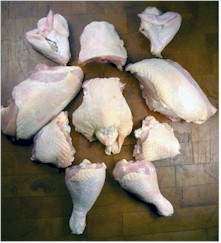
Back in the day, "whole" was the way chicken was sold and home-cooks knew just what to do with it—cutting their own chicken was no big deal. But according to the research I did, and according to the random survey I took to prepare for this article, cutting a whole chicken IS a big deal today. In fact, most folks I talked to consider the idea far beyond their skill set. So if you can relate, I thought you might find it helpful to see how the pros cut up a whole chicken. And if you're one of those folks that already knows how to do this, read on anyway—I close with a great recipe.
You'll want to be sure you use a sharp butcher's knife and have a sanitized cutting board ready. (And here's something professional chefs do to keep their cutting board from slipping and sliding all over the countertop: They place a couple dampened paper towels under the board to keep it anchored.) The overall technique calls for finding where the joints connect and cutting through them. Generally speaking, you shouldn't be sawing through too much chicken bone.
- 1. Remove the legs: The "leg" of a chicken includes what's called a drumstick and a thigh. Place the chicken breast-side up on a solid cutting board. Pull one leg away from the body and cut through the skin between the body and both sides of the thigh. Bend the whole leg firmly away from the body until the ball of the thighbone pops from the hip socket. Cut between the ball and the socket to separate the leg. Repeat this process on the other leg.
- 2. Divide the legs: Place the chicken leg skin-side down on the cutting board. Cut down firmly through the joint between the drumstick and the thigh.
- 3. Remove the wings: With chicken on its back, remove wing by cutting inside of wing just over joint. Pull wing away from body and cut down through the skin and the joint. Repeat with the other wing.
- 4. Cut carcass in half: Cut through the cavity of the bird from the tail end and slice through the thin area around the shoulder joint. Cut parallel to the backbone and slice the bones of the rib cage. Repeat on the opposite side of the backbone.
- 5. Remove the breast: Pull apart the breast and the back. Cut down through the shoulder bones to detach the breast from the back. Cut the back into two pieces by cutting across the backbone where the ribs end.
- 6. Cut breast in half: You can leave the breast whole if your recipe requires. To cut in half, use a strong, steady pressure and cut downward along the length of the breastbone to separate the breast into two pieces. This is the one place where you're actually cutting through true bone.
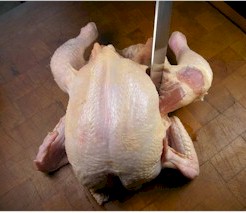
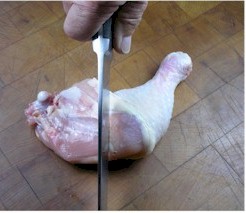
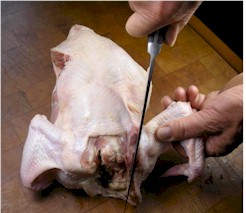
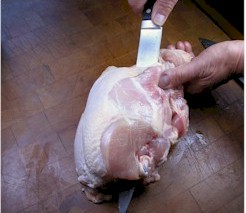
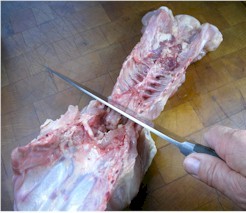
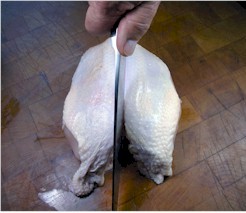
It goes without saying that immediately after cutting your chicken you wash your knife and cutting board with hot, sudsy water. I let the board air dry and then sanitize it with a spray of my kitchen sanitizer made from 20 drops of GSE (grapefruit-seed extract), 5 drops of peppermint essential oil, and 3 or 4 drops of eucalyptus essential oil, all mixed about 1 quart of water.
Moving on: When you're not in the mood or don't have the time to cut up your whole chicken, cooking the entire thing is not only easy, but incredibly delicious. And this is where big savings shows up—you can get at least 3 meals from a whole chicken, and that's really why buying a whole chicken is a big deal. The first meal is from your roasted chicken (save about a cup of chicken meat for your next meal); the second meal is built on this reserved cup of chicken—enchiladas, pita pockets, stir fry, noodle casserole—the possibilities are endless; the third meal is soup made from the chicken carcass that you saved and refrigerated.
If roasting the entire chicken is your preference, here's a favorite recipe my Aunt Annie used for all company dinners. And besides the superb meal this recipe provides, there are the amazing aromas baking chicken sends through the house. Life is good...
- www.gourmetsleuth.com
- www.eatingwell.com
 Alice Osborne
Alice Osborne
Weekly Newsletter Contributor since 2006
Email the author! alice@dvo.com
Recipe
HERBED WHOLE CHICKEN
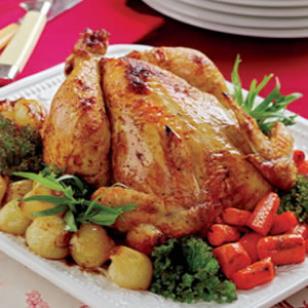
Serving size: 5
Calories per serving: 192
1 whole (4-5 lb) roasting chicken, giblets removed
1/2 cup extra virgin olive oil
12 garlic cloves, chopped
leaf from 2 sprigs fresh rosemary
1 lemon, zested and sliced thinly
2 teaspoons each salt and pepper
Directions:
Whisk together the olive oil, garlic, rosemary, lemon zest, salt and pepper (you can also leave the garlic cloves whole and blend it all together in a food processor or blender).
Pour a bit of the oil-garlic mixture into the cupped palm of your hand and rub it over the skin of the chicken on both sides. Gently slide your hands between the skin and the flesh of the chicken and rub some of the oil mixture beneath the skin. Pour a bit more oil into your hands and rub the cavity of the chicken with it. Continue until the whole chicken is covered with the garlic-oil mixture.
Place a few slices of lemon between the skin and the flesh. Stuff the rest of the slices into the cavity. Arrange chicken breast-side-up in the pan and use kitchen twine or a couple of toothpicks to attach the legs together. Cover the pan tightly with aluminum foil.
Bake, covered, for 30 minutes. Remove the foil and bake, uncovered, for another 25-30 minutes, or until the skin is golden-brown and the juices run clear (stab a knife into the thigh to check this). Cut into pieces and serve hot.
If you want to make pan gravy to serve with your chicken, remove 2 to 3 tablespoons of chicken liquid and whisk in 1 to 2 tablespoons of all purpose flour. Pour the remaining chicken liquid into a small pan and bring the mixture to a light boil. Whisk constantly until liquid thickens and you have a nice creamy gravy. Season with salt and pepper to taste.
Recipe formatted with the Cook'n Recipe Software from DVO Enterprises.
